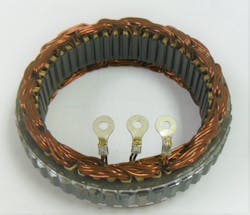When it comes to tools and equipment, this subject is forever changing. What you need to be safe and do a quality job on repair, diagnostic and preventive maintenance on EMVs (vehicles with high voltage systems) has changed over the years, and some in the aftermarket have barely kept up. The OEMs have required tool lists that a new vehicle dealership must have in order to sell the EMV. That list changes as newer models are sold. What you can learn in this article is an overview of what is out there on the high voltage electrical side. Before you take on any job that you have never done, it is wise to look at the service information and review what tools are needed — before you start.
Digital volt-ohm meters
When using a digital volt-ohm meter (DVOM) or digital multimeter (DMM) on any high voltage system (more than 60 volts DC), make sure that the meter, leads, ends and any other attachment that are connected to the meter are rated CAT III at 1,000 volts. I will use the term DVOM, not DMM. The voltage levels of some electric vehicles are 800 volts. Many older CAT III-rated meters were limited to 600 volts. Around the year 2000, CAT III 1,000-volt meters were offered. In M/Y 2004, Toyota added a boost converter to their Prius that raised the voltage to 500 volts. Safely controlling voltages much higher than 900 volts is a safety concern for most OEMs.
When using a DVOM, make sure your meter is rated for the work environment you are in. Many shops have moved all the CAT III 1000-volt meters, scopes and other equipment to a new tool box that is clearly marked “CAT III 1,000 volts only”. Some have gone as far as to replace every old piece of tooling or equipment with a CAT III 1,000-volt-rated unit. No matter what you do, be safe and do not take unnecessary chances.
Using the meter on an HV circuit
The meter ratings (CAT II, III, IV, etc.) are based on the spacing between the components inside the case and the possibility of an explosion. The meter screen is the weakest part of the meter and the most likely to become a projectile if the meter is hit with more voltage and current than it can safely read. It takes about the same amount of time to do something right as it does to do it wrong. “Safe down” procedures want you to confirm that the HV battery has been disconnected from the rest of the system and the HV capacitors have been discharged as they are designed to do. Your equipment, and its proper use and care, is a personal safety issue.
Milliohm meter
When induction motors were introduced (thank you GM and Tesla), a milliohm meter became a vital piece of equipment. The choice of a scope or a meter is dependent on a voltage signal you are measuring. If the voltage varies, use a scope. What if there is no voltage? Induction motors do not produce voltage when the rotor is spun manually while disconnected from the inverter. Therefore, a precise measurement of the stator windings in an induction motor must be made with a milliohm meter when the electric motor is being tested. You may be wondering why your DVOM’s ohm reading is not up to the job. When you use a DVOM against a milliohm meter it will become obvious. Any resistance that is over one ohm will accurately report that resistance to your DVOM. When the ohm specification is under one ohm, then your meter is not useful as it will not measure correctly under one ohm. The reading will be off, so a milliohm meter must be used. Toyota has a specification of 0.016 ohm for the stator windings in some motors.
Insulation tester
This type of tester will produce 50 to 1,000 DC volts to test the insulation of the HV cables and some high voltage circuits. The current produced is milli-amps for safety reasons. The manuals are easy to understand but the difficulty is knowing where to connect the leads. Understanding the “construction and function” of all the parts that make up an EMV is required so you know where to test. Make sure you carefully examine the cross section of high voltage cables. If you have access to spare high voltage orange cables, cut them in half and then use a belt sander to make it easier to see the layers of the cables. Note the shielding and when and where it is used. Note the grounding of the shielding both in external cables and those used inside HV components. When using an “insulation tester” be sure the capacitors have been discharged and the HV battery pack is off. Safety is always number one.
Stray or ghost voltage eliminators
A high impedance meter presents virtually no load to the circuit under test. By design, this is the ideal situation, since you don’t want to have the meter loading the circuit and affecting the circuit measurements. Ghost voltage reading may be as high as 50% of the energized voltage in the same proximity. Is this voltage real? Yes, it is, but it’s static voltage, containing no real energy or current flow. For the tech who needs to determine whether a circuit or connection is energized or not, this stray voltage reading presents a real source of confusion. Is the connection hot or not?
The Fluke SV225 stray voltage adapter
The articles I have written are brand neutral. In this case the only product on the market I have ever found that works with a DVOM (and I have looked hard) is made by Fluke. The stray voltage adapter is a DVOM accessory part that allows the DVOM to measure circuits subject to stray or ghost voltages from adjacent energized wiring. The adapter provides a low impedance load to the measured circuit that desensitizes the meter to low energy sources of interference. It allows a high impedance DVOM to make an accurate determination as to whether the circuit under test is energized or not. Using this adapter allows the tech to determine whether a circuit, connection, cable or connector is energized. If the measurement points are energized with a “hard” voltage, the meter will simply display the voltage reading. If the measurement points contain a stray or ghost voltage, the meter will read very close to zero volts indicating the circuit or connection is deenergized.
Summary
The news continues to favor EVs over internal combustion. In 1999 I started my training into high voltage safety after I bought a Honda Insight hybrid. It has been a journey that I have taken with thousands of others who were involved in this transition. I have had the good fortune of working closely with those who engineered, built and ultimately fixed the EMVs that presented concerns to the owners. As a shop owner/technician/journalist/technician trainer it has been amazing to see this technology grow. The road has had its share of potholes, danger signs and detours, but we are still moving forward and at a much faster rate of speed. The future awaits us but the EMVs are here now, so get ready. This technology is not going away.
About the Author

Craig Van Batenburg
Craig Van Batenburg is the CEO of ACDC, a hybrid and plug-in training company based in Worcester, Mass. ACDC has been offering high voltage classes since 2000, when the Honda Insight came to the USA. When EVs were introduced in 2011, ACDC added them to their classes. Reach Craig via email at [email protected] or call him at (508) 826-4546. Find ACDC at www.FIXHYBRID.com.
